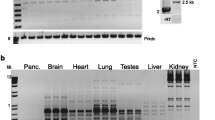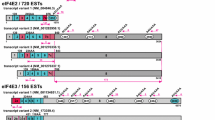Abstract
The human pregnane X receptor (PXR) is a crucial regulator of the genes encoding several major cytochrome P450 enzymes and transporters, such as CYP3A4 and MDR1, but its own transcriptional regulation remains unclear. To elucidate the transcriptional mechanisms of human PXR gene, we first endeavored to identify the transcription initiation site of human PXR using 5′-RACE. Five types of 5′-variable transcripts (a, b, c, d, and e) with common exon 2 sequence were found, and comparison of these sequences with the genomic sequence suggested that their 5′ diversity is derived from initiation by alternative promoters and alternative splicing. None of the exons found in our study contain any new in-frame coding regions. Newly identified introns IVS-a and IVS-b were found to have CT-AC splice sites that do not follow the GT-AG rule of conventional donor and acceptor splice sites. Of the five types of 5′ variable transcripts identified, RT-PCR showed that type-a was the major transcript type. Four transcription initiation sites (A–D) for type-a transcript were identified by 5′-RACE using GeneRacer RACE Ready cDNA (human liver) constructed by the oligo-capping method. Putative TATA boxes were located approximately 30 bp upstream from the transcriptional start sites of the major transcript (C) and the longest minor transcript (A) expressed in the human liver. These results indicate that the initiation of transcription of human PXR is more complex than previously reported.
Similar content being viewed by others
References
Bertilsson G, Heidrich J, Svensson K, Asman M, Jendeberg L, Sydow-Backman M, Ohlsson R, Postlind H, Blomquist P, Berkenstam A: Identification of a human nuclear receptor defines a new signaling pathway for CYP3A induction. Proc Natl Acad Sci USA 95: 12208–12213, 1998
Blumberg B, Sabbagh W, Jr, Juguilon H, Bolado J, Jr, van Meter CM, Ong ES, Evans RM: SXR, a novel steroid and xenobiotic-sensing nuclear receptor. Genes Dev 12: 3195–3205, 1998
Kliewer SA, Moore JT, Wade L, Staudinger JL, Watson MA, Jones SA, McKee DD, Oliver BB, Willson TM, Zetterstrom RH, Perlmann T, Lehmann JM: An orphan nuclear receptor activated by pregnanes defines a novel steroid signaling pathway. Cell 92: 73–82, 1998
Lehmann JM, McKee DD, Watson MA, Willson TM, Moore JT, Kliewer SA: The human orphan nuclear receptor PXR is activated by compounds that regulate CYP3A4 gene expression and cause drug interactions. J Clin Invest 102: 1016–1023, 1998
Xie W, Barwick JL, Simon CM, Pierce AM, Safe S, Blumberg B, Guzelian PS, Evans RM: Reciprocal activation of xenobiotic response genes by nuclear receptors SXR/PXR and CAR. Genes Dev 14: 3014–3023, 2000
Smirlis D, Muangmoonchai R, Edwards M, Phillips IR, Shephard EA: Orphan receptor promiscuity in the induction of cytochromes p450 by xenobiotics. J Biol Chem 276: 12822–12826, 2001
Goodwin B, Moore LB, Stoltz CM, McKee DD, Kliewer SA: Regulation of the human CYP2B6 gene by the nuclear pregnane X receptor. Mol Pharmacol 60: 427–431, 2001
Sueyoshi T, Negishi M: Phenobarbital response elements of cytochrome P450 genes and nuclear receptors. Annu Rev Pharmacol Toxicol 41: 123–143, 2001
Gerbal-Chaloin S, Daujat M, Pascussi JM, Pichard-Garcia L, Vilarem MJ, Maurel P: Transcriptional regulation of CYP2C9 gene. Role of glucocorticoid receptor and constitutive androstane receptor. J Biol Chem 277: 209–217, 2002
Xie W, Yeuh MF, Radominska-Pandya A, Saini SP, Negishi Y, Bottroff BS, Cabrera GY, Tukey RH, Evans RM: Control of steroid, heme, and carcinogen metabolism by nuclear pregnane X receptor and constitutive androstane receptor. Proc Natl Acad Sci USA 100: 4150–4155, 2003
Geick A, Eichelbaum M, Burk O: Nuclear receptor response elements mediate induction of intestinal MDR1 by rifampin. J Biol Chem 276: 14581–14587, 2001
Synold TW, Dussault I, Forman BM: The orphan nuclear receptor SXR coordinately regulates drug metabolism and efflux. Nat Med 7: 584–590, 2001
Guo GL, Staudinger J, Ogura K, Klaassen CD: Induction of rat organic anion transporting polypeptide 2 by pregnenolone-16alpha-carbonitrile is via interaction with pregnane X receptor. Mol Pharmacol 61: 832–839, 2002
Kast HR, Goodwin B, Tarr PT, Jones SA, Anisfeld AM, Stoltz CM, Tontonoz P, Kliewer S, Willson TM, Edwards PA: Regulation of multidrug resistance-associated protein 2 (ABCC2) by the nuclear receptors pregnane X receptor, farnesoid X-activated receptor, and constitutive androstane receptor. J Biol Chem 277: 2908–2915, 2002
Heinemeyer T, Wingender E, Reuter I, Hermjakob H, Kel AE, Kel OV, Ignatieva EV, Ananko EA, Podkolodnaya OA, Kolpakov FA, Podkolodny NL, Kolchanov NA: Databases on transcriptional regulation: TRANSFAC, TRRD and COMPEL. Nucleic Acids Res 26: 362–367, 1998
Akiyama Y: TFSEARCH: Searching Transcription Factor Binding Sites. http://www.cbrc.jp/research/db/TFSEARCH.html, 1998
Hustert E, Zibat A, Presecan-Siedel E, Eiselt R, Mueller R, Fuss C, Brehm I, Brinkmann U, Eichelbaum M, Wojnowski L, Burk O: Natural protein variants of pregnane X receptor with altered transactivation activity toward CYP3A4. Drug Metab Dispos 29: 1454–1459, 2001
Chenchik A, Zhu Y, Diatchenko L, Li R, Hill J, Siebert P: Generation and use of high-quality cDNA from small amounts of total RNA by SMART PCR. In: P. Siebert, J. Larrick (eds). RT-PCR Methods for Gene cloning and Analysis. Bio Techniques Books, MA, 1998, pp 305–319
Patel AA, Steitz JA: Splicing double: Insights from the second spliceosome. Nat Rev Mol Cell Biol 4: 960–970, 2003
Thanaraj TA, Clark F: Human GC-AG alternative intron isoforms with weak donor sites show enhanced consensus at acceptor exon positions. Nucleic Acids Res 29: 2581–2593, 2001
Burset M, Seledtsov IA, Solovyev VV: Analysis of canonical and non-canonical splice sites in mammalian genomes. Nucleic Acids Res 28: 4364–4375, 2000
Fukuen S, Fukuda T, Matsuda H, Sumida A, Yamamoto I, Inaba T, Azuma J: Identification of the novel splicing variants for the hPXR in human livers. Biochem Biophys Res Commun 298: 433–438, 2002
French C, Menegazzi P, Nicholson L, Macaulay H, DiLuca D, Gompels UA: Novel, nonconsensus cellular splicing regulates expression of a gene encoding a chemokine-like protein that shows high variation and is specific for human herpesvirus 6. Virology 262: 139–151, 1999
Plant NJ, Gibson GG: Evaluation of the toxicological relevance of CYP3A4 induction. Curr Opin Drug Discov Dev 6: 50–56, 2003
Farrer T, Roller AB, Kent WJ, Zahler AM: Analysis of the role of Caenorhabditis elegans GC-AG introns in regulated splicing. Nucleic Acids Res 30: 3360–3367, 2002
Author information
Authors and Affiliations
Corresponding author
Rights and permissions
About this article
Cite this article
Kurose, K., Koyano, S., Ikeda, S. et al. 5′ Diversity of human hepatic PXR (NR1I2) transcripts and identification of the major transcription initiation site. Mol Cell Biochem 273, 79–85 (2005). https://doi.org/10.1007/s11010-005-7757-7
Received:
Accepted:
Issue Date:
DOI: https://doi.org/10.1007/s11010-005-7757-7




